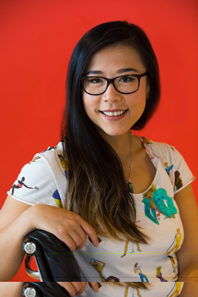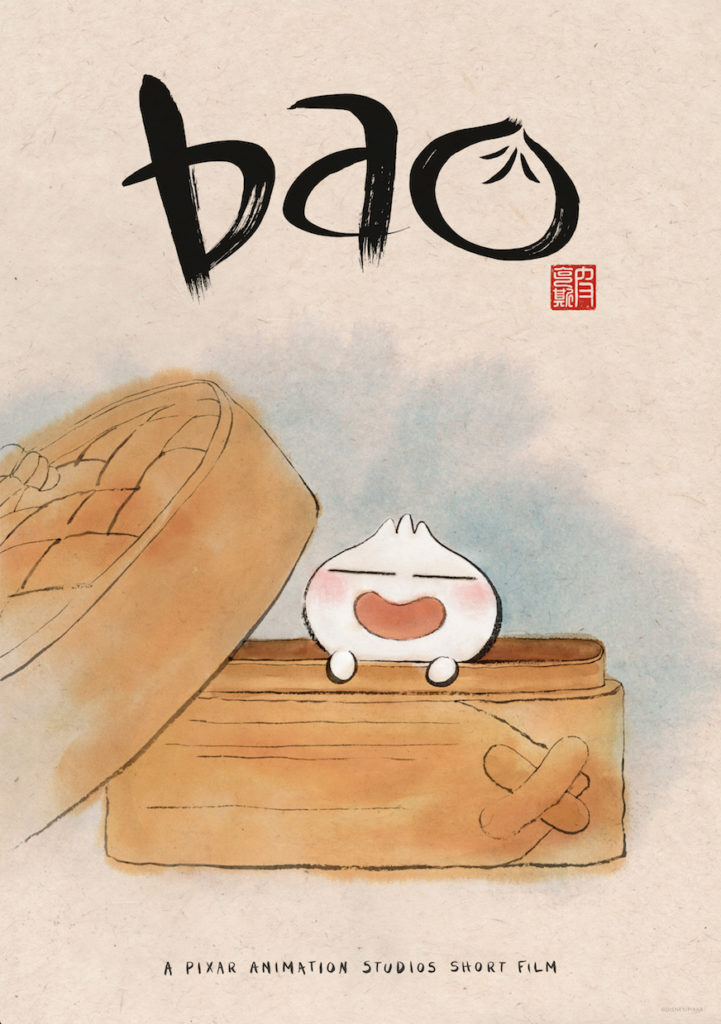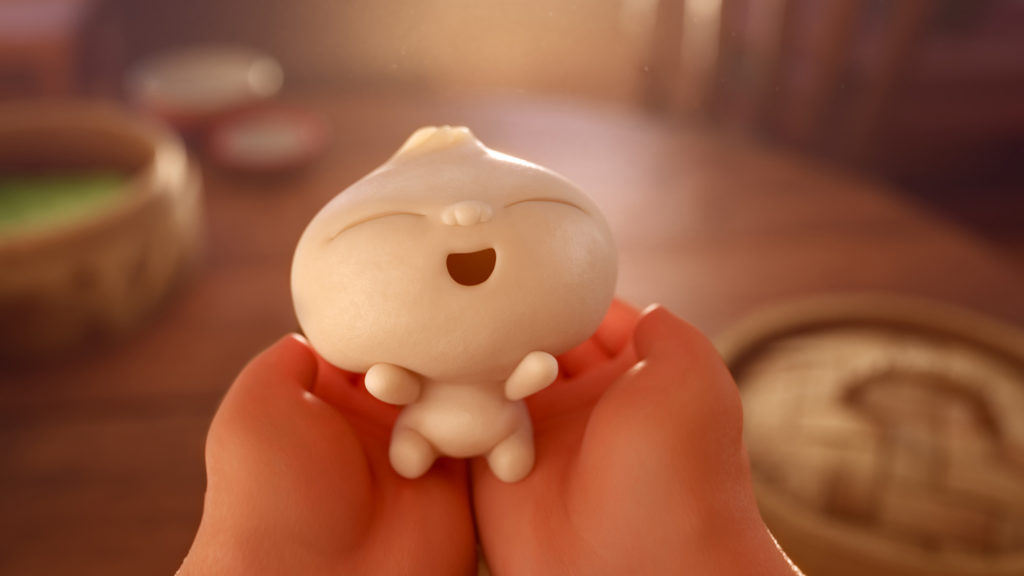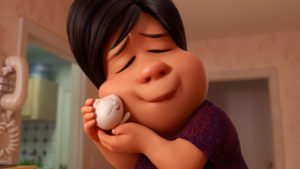
It’s always important to give some love to the home town talent…
In Disney/Pixar’s Bao, an aging Chinese mom suffering from empty nest syndrome gets another chance at motherhood when one of her dumplings springs to life as a lively, giggly dumpling boy. Mom excitedly welcomes this new bundle of joy into her life, but Dumpling starts growing up fast, and Mom must come to the bittersweet revelation that nothing stays cute and small forever.
This short film from Pixar Animation Studios and director Domee Shi explores the ups and downs of the parent-child relationship through the colourful, rich, and tasty lens of the Chinese immigrant community in Canada.
A rising star at Pixar with stellar work on films like Inside Out & Incredibles 2 it seems fitting Domee Shi gets her first chance in the spotlight with the somewhat autobiographical Bao which will undoubtedly win over audiences with its unexpected charm and adorable tone.
Before Bao & Incredibles 2 hit theatres this week we got to sit down with Domee Shi and get a little bit of first hand insight from inside the magic that is Pixar studios.
 DV: You’ve cited a lot of your influences from things like anime, manga, Studio Ghibli and Asian cinema like the works of Ang Lee among others. What titles have inspired you the most, creatively, and how have you been able to incorporate these influences into your work as a story artist on such films as Incredibles 2 and Toy Story 4 and, of course here with Bao?
DV: You’ve cited a lot of your influences from things like anime, manga, Studio Ghibli and Asian cinema like the works of Ang Lee among others. What titles have inspired you the most, creatively, and how have you been able to incorporate these influences into your work as a story artist on such films as Incredibles 2 and Toy Story 4 and, of course here with Bao?
DS: All of those filmmakers and styles you just mentioned have been pivotal for me and I have always found that Asian cinema has always been a big source of inspiration for me. They just have a different approach to filmmaking and storytelling and really care about depicting the moment and the mood at any given moment rather than just being all about plot. The films of Yasujiro Ozu have also been a huge influence on me and especially here with Bao, as we studied several of his films like Tokyo Story & An Autumn Afternoon because I love he holds the camera incredibly still and really lets his characters just exist inside the frame, and I really wanted to do that with these particular characters on this short film as well.
Hayao Miyazaki and his films have also been a huge influence on me. I just love how he seamlessly blends elements of magic with real characters that are grounded in these real emotions. His stories are so lyrical and they kind of just take you a long for a ride and you’re never quite that sure where you’ll end up. I wanted to bring elements like that into Bao as well.
How important is it to have finger on the pulse of world cinema and try to watch everything while you are deep inside a creative think tank like Pixar?
Oh my god, it’s SO important!
Everyone who works at the studio really is at the top of their game but they are always referencing at least what I feel are a lot of the same films and it’s so important in this business to try and keep things fresh. Obviously one way to do that is to begin to reference films that come from outside of your own country and Hollywood, plus there’s just so much high quality foreign film out right now and it is just such a great way to be exposed to films that tell stories in a different way from our own and it really is such a gold mine of material for ideas in so many ways. For me was so valuable to indulge in all sorts of Asian cinema and their styles to learn about it all and try and bring something fresh and unique to the table that maybe hasn’t been done before at Pixar.
When you first pitched your idea for Bao, how far into the process were you?
When I did my initial pitch I had a basic storyboard with a very basic beginning, middle and end. I drew a lot of the key story moments in the short, particularly the birth of the dumpling when he comes alive, his interactions with his mother and their eventual reunion. I drew it all out and pinned it to a board and pitched it to everyone on the panel because I really am a storyteller through drawings; it’s my background, my real strength (my super-power) as it were and I knew I was never the strongest with dialogue, so I came in with as many strong visuals as I could in order to really get the story across.
Now you’ve done shorts before (particularly during your time at Sheridan). What do you find the biggest difference has been between doing something on your own and doing something inside the Pixar machine?
Oh wow! SO MUCH…especially since Well Being which I made at Sheridan was quite literally the very first short I had ever made and I quite literally knew nothing about filmmaking as was super, super green at the time. Back then I really was learning on the fly about all departments because it all rests on your shoulders and it’s all up to you. Granted you get full creative control, but that’s only to the point where your actual abilities can take you. However at Pixar you get to work with so many people (many who are WAY more talented then you and know so many more different things in areas that you’ve never even studied like technology, animation, lighting, shading, painting, everything! You have so many more tools at your disposal but your job really is different, because while at Pixar as a director really your job is to communicate your idea and your vision to a large group of people and be able to work with all of them together, pointing everyone to a singular direction. In many ways that’s actually harder than doing something on your own because really the only person you have to get your ideas across to is yourself! Working at Pixar on a short film, you really do have to learn how to get your message across in as clearly as you can, to as many people as possible.
Does that mean letting go creatively as well?
Yeah, but not as much as you might think it’s more just about realizing how different people can really add their own spin to your voice and truly make it better. It’s about letting go of the ego, if only a little bit and really being open to the sounding board of ideas that are at your fingertips when working on something like this.
It’s not often in these Pixar shorts that we actually get geographical landmarks tying them to an actual place, but here we see the CN Tower, see a streetcar on the TTC. How important was it for you to have Toronto as a character here in Bao?
It really was important for me because it felt like having those specific landmarks really grounded the story and grounded those characters and it made them feel like real people who were living in a real space. The character designs are really so “cartoony” it was important for us to get the details around them to feel as accurate as humanly possible, not just the Chinese style home but the city that they live in as well including everything from the TTC bus they ride on to the shops they visit and because the short really is inspired by my life and I was the overprotected little Chinese dumpling living in the city with my Chinese mom, I figured why not have it all take place in my home town and have it turn into a little homage to my hometown. Plus by grounding in an actual place, we could just pull up pictures of the TTC for set design reference and see the CN Tower or pictures of Chinatown and have it all as a jumping off point as we built everything up. Sometimes when it’s a little too generic, you can have some design elements be all over the maps and this helped to really ground it and give it a solid base to build from. Made everything that much more focused from beginning to end.
Bao is now playing in front of The Incredibles 2 in theatres across the country.

